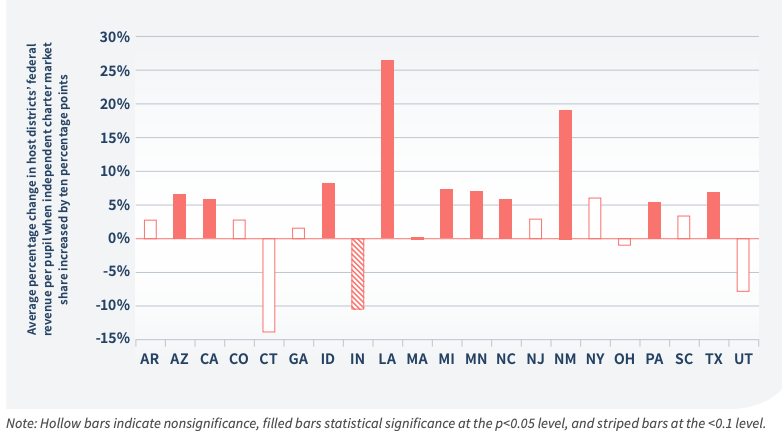Report finds charter schools don’t drain money from district schools
Critics of charter schools often state that these schools hurt traditional school districts by “draining” and “funneling” money and resources away from them. But do they?
A new report by Mark Weber and commissioned by the Fordham Institute finds that charter schools aren’t the drain on district finances critics claim them to be. In fact, in most of the states that the report analyzes, “an increase in the percentage of students attending independent charter schools was associated with a significant increase in host districts’ total revenue and spending per pupil.” Other key findings include:
- In most states, an increase in the percentage of students attending independent charter schools was associated with an increase in host districts’ local revenue per pupil, and in some states, it was also associated with an increase in state and/or federal revenue per pupil.
- In most states, an increase in the percentage of students attending independent charter schools was associated with an increase in host districts’ per-pupil spending on support services, and in some states, it was also associated with an increase in instructional spending per pupil.
Such findings pair well with growing research “that suggests charter competition has a neutral-to-positive effect on the achievement of students in traditional public schools,” David Griffith and Michael Petrilli conclude in the report’s foreword. “Now someone needs to tell President Biden.”
The report focuses on independent charter schools because they are not authorized by traditional school districts and tend to be the ones most critics find worrisome. Twenty-one states (including Minnesota) were analyzed, with fiscal data reported by traditional public school districts between 2000 and 2017, enrollment data and student demographics used to generate estimates of the financial relationship between independent charter schools and host school districts. While 45 states currently have charter schools, 21 states were selected because they had at least 10 districts that hosted an independent charter school at the end of the study period with reliable fiscal data.
A higher independent charter market share is associated with increase in host districts’ total revenue per pupil
In Minnesota, total revenue per pupil increased when the independent charter market share increased by 10 percentage points, which is contrary to critics’ talking points that charter schools drain district resources.

A higher independent charter market share is associated with increase in host districts’ local revenue per pupil
K-12 school revenue comes from the local level, the state level, and the federal level. State and local revenue account for the largest revenue streams, with federal revenue composing the smallest part. In Minnesota, K-12 school revenue at the local level increased when the independent charter market share increased by 10 percentage points. Minnesota ranks 32nd among the 50 states and District of Columbia in local revenue per pupil ($4,624), according to 2018 data from the U.S. Census Bureau.

A higher independent charter market share is associated with increase in host districts’ federal revenue per pupil
In Minnesota, K-12 school revenue at the federal level increased when the independent charter market share increased by 10 percentage points. Minnesota ranks 49th among the 50 states and District of Columbia in federal revenue per pupil ($802), according to 2018 data from the U.S. Census Bureau.

A higher independent charter market share is associated with increase in host districts’ support spending per pupil
Typically, the largest chunks of K-12 spending go toward instructional spending and support spending. Instructional spending covers expenses for student instruction, including teacher salaries and benefits, while support spending covers administration expenses, counselors, social workers, library staff, transportation, etc. Critics of charter schools would likely be surprised to discover that in Minnesota, support spending per pupil increased when the independent charter market share increased by 10 percentage points.

While these results are positive, Weber notes they “are a description of the past and not necessarily a prediction for the future,” as laws determining district and charter school funding can and will change. That said, the patterns from this report on spending and revenues increasing when charter enrollments grow are worth further research, Weber concludes.
With these data, wouldn’t it make sense for advocates of increased public school funding to also support expanding charter schools?
Such findings, though, are problematic for teachers’ unions and the Biden administration. President Biden has “promised to increase federal resources for district-run public schools through more COVID-19 emergency funding and by halting the growth of public charter schools,” writes Patrick Wolf with the Fordham Institute. But by limiting charter school enrollments, “the Biden administration would reduce the resources available to students in district-run public schools, according to Weber’s findings.”